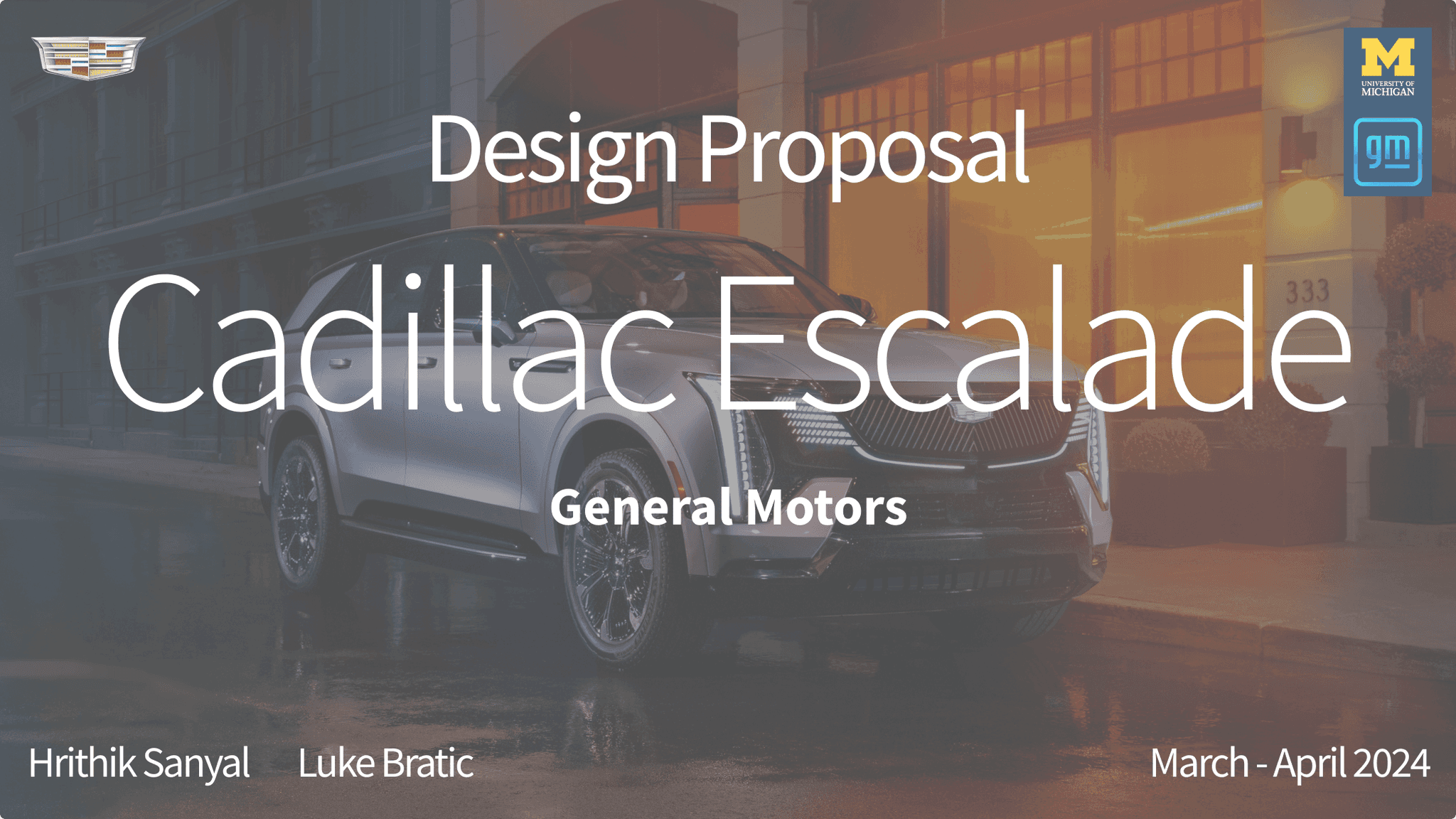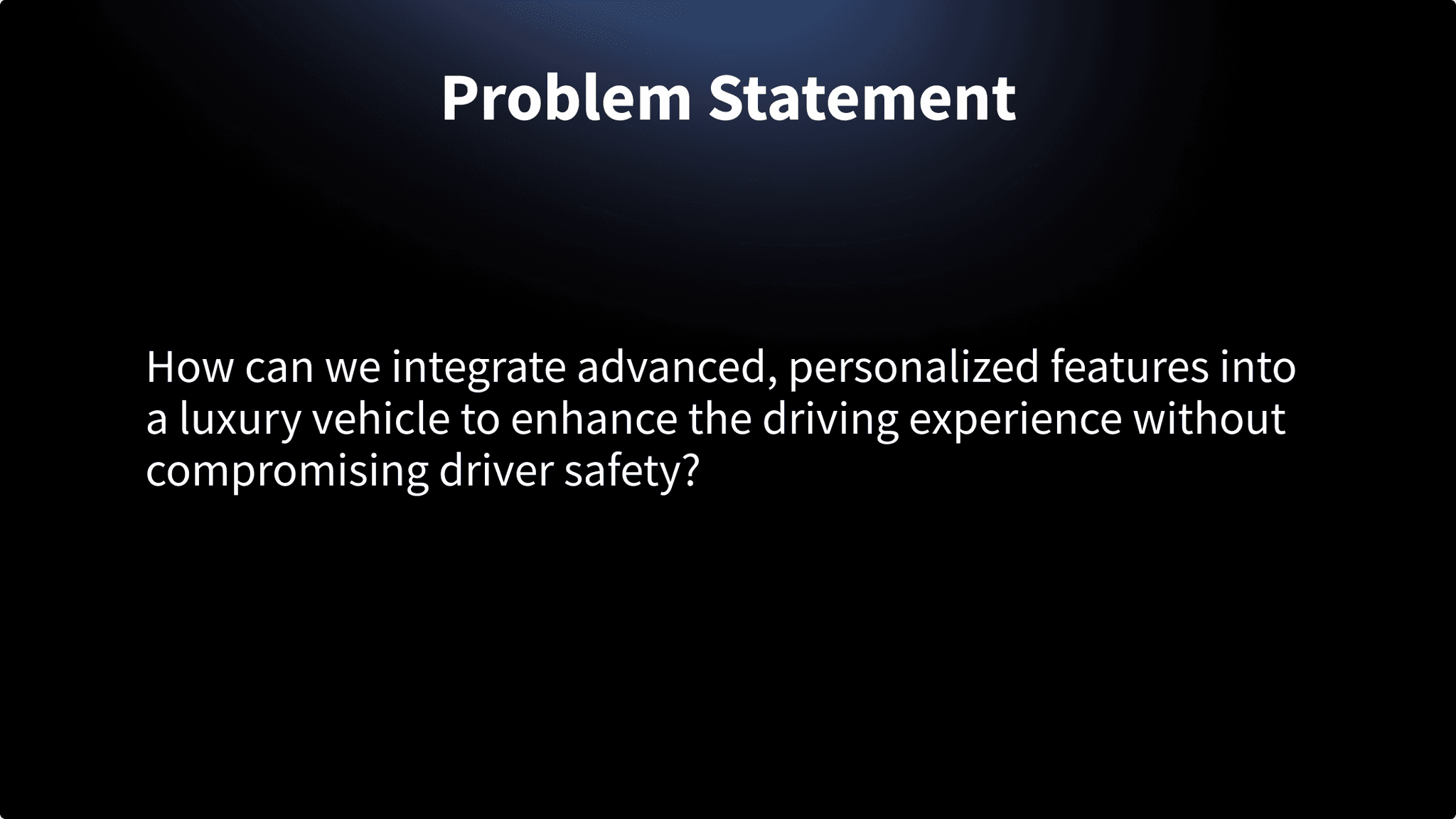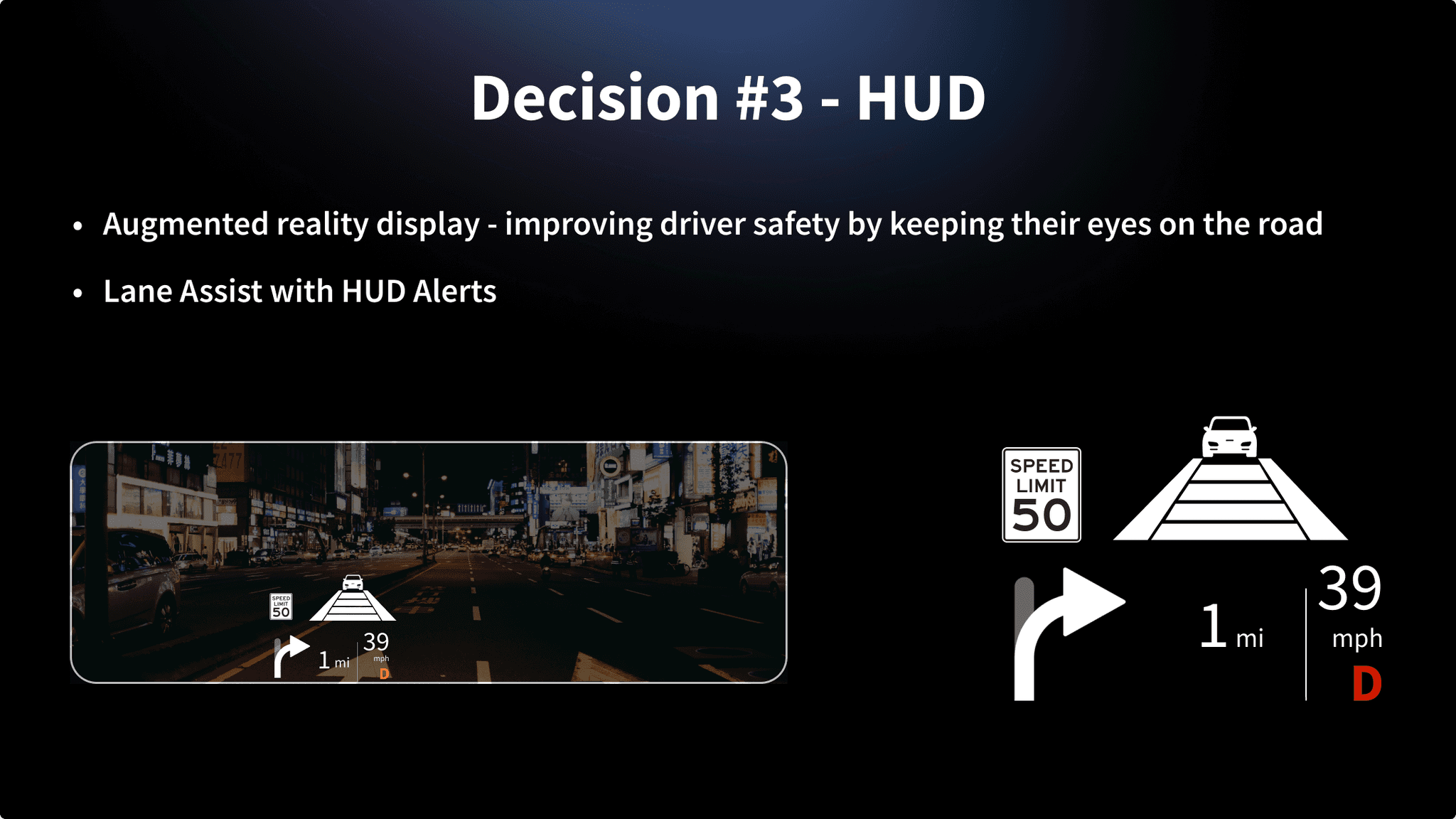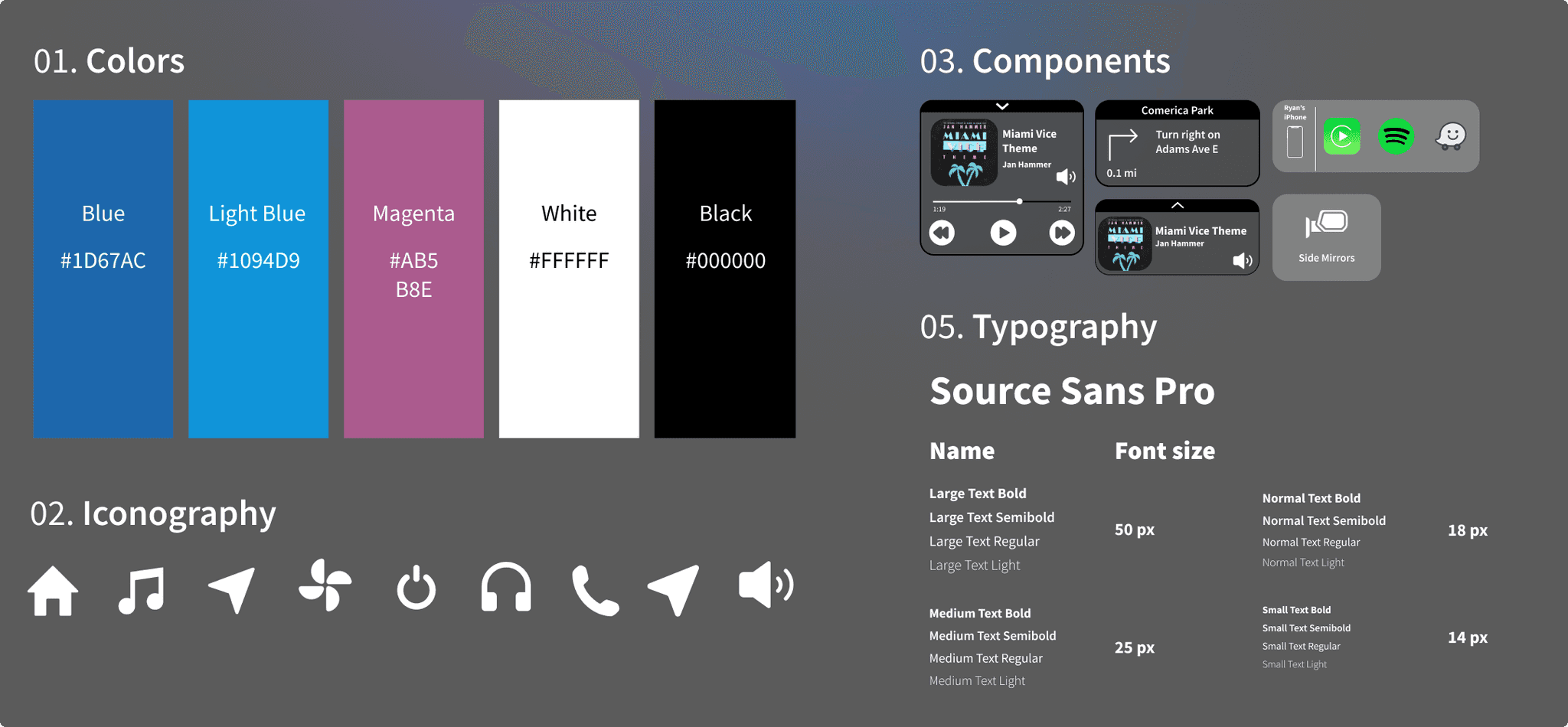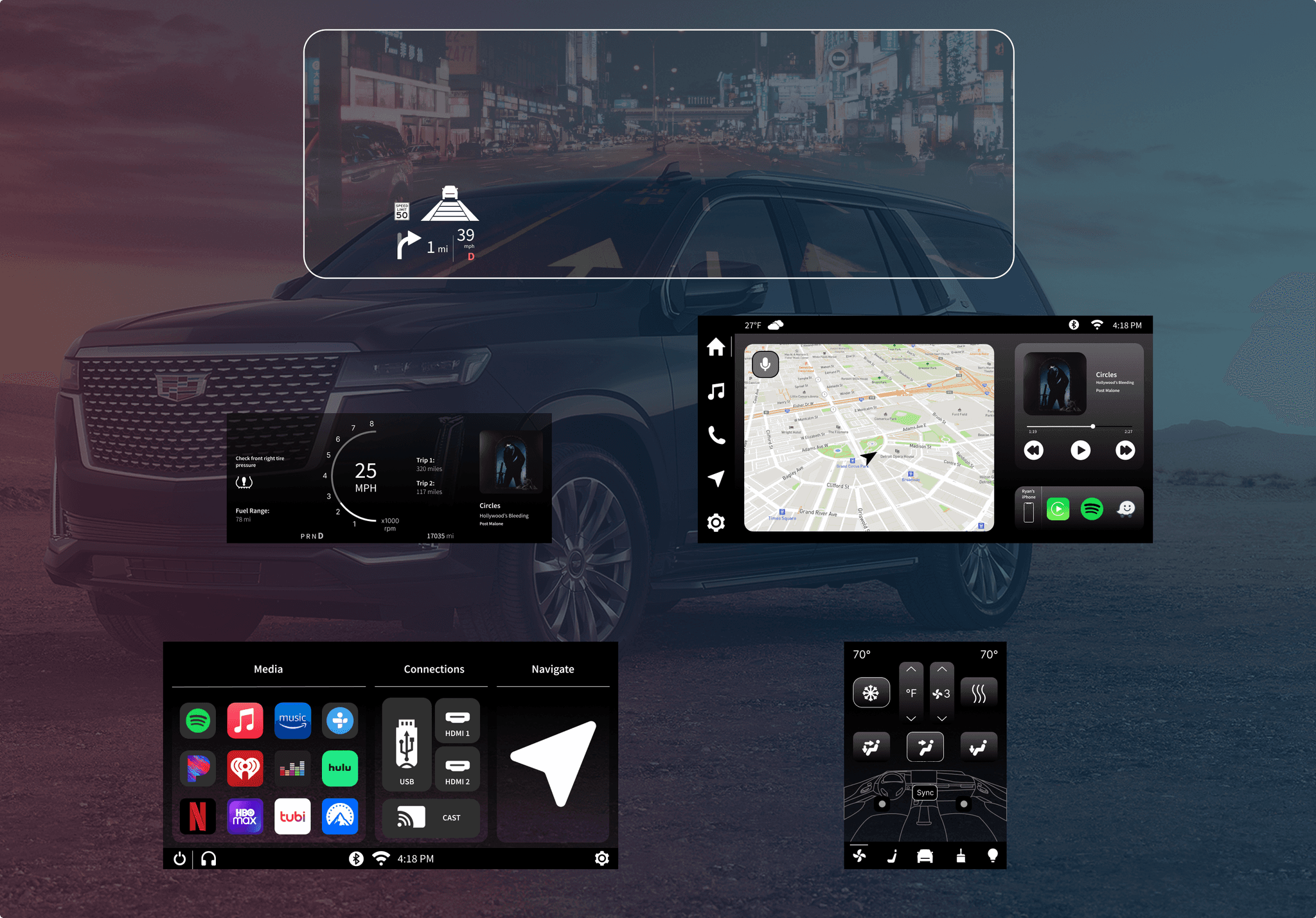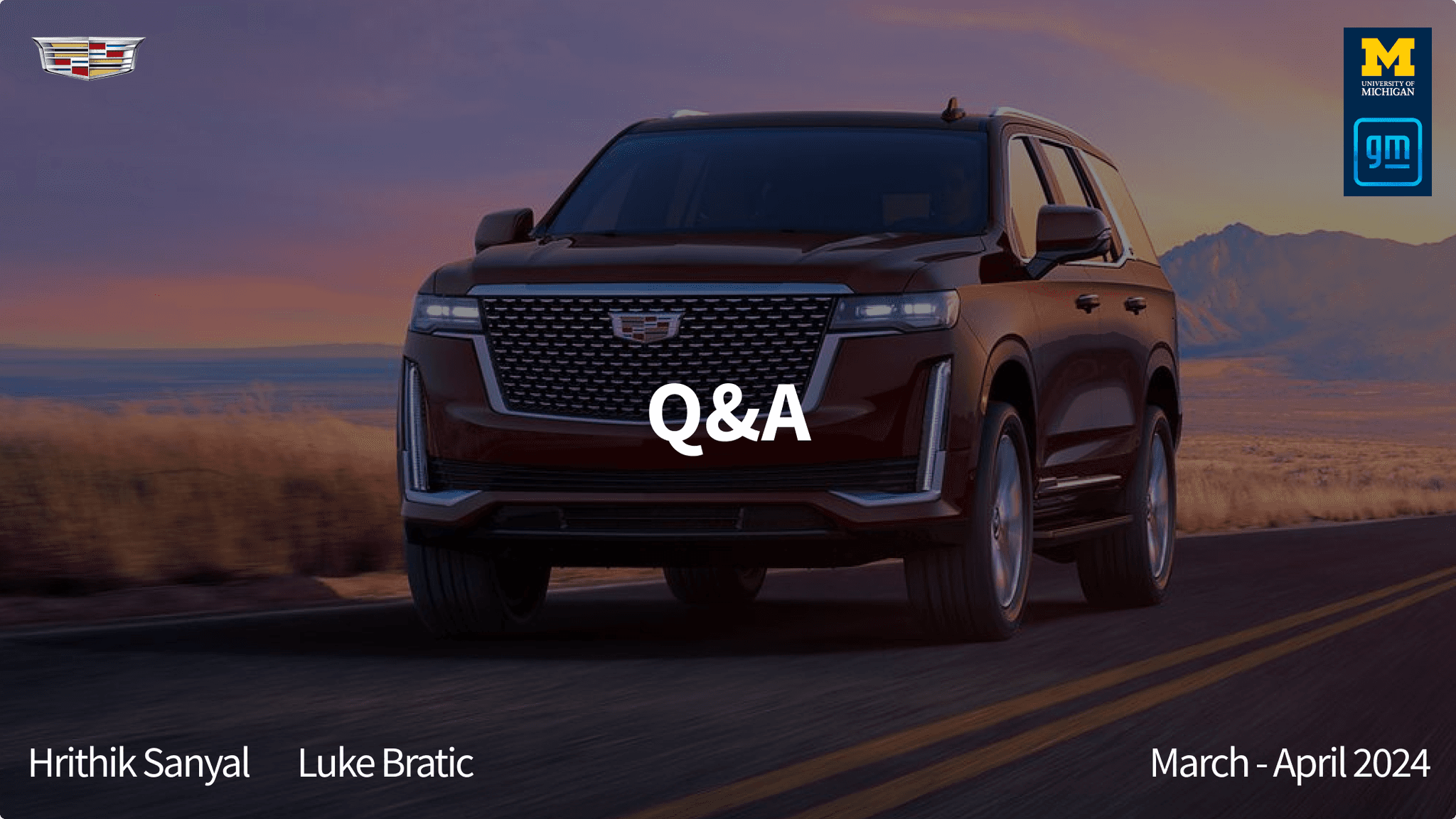Automotive UX - Cadillac Escalade Design Proposal
Automotive UX - Cadillac Escalade Design Proposal
Automotive UX - Cadillac Escalade Design Proposal

Speed Read In a rush?
Here's the gist.
Speed Read In a rush?
Here's the gist.
Process
Process
I led user research, designed wireframes, and iterated through three phases: low-fidelity sketches, high-fidelity prototypes, and usability testing. Using Figma, I ensured AI personalization and HCM principles were central to the design, balancing safety and innovation.
I led user research, designed wireframes, and iterated through three phases: low-fidelity sketches, high-fidelity prototypes, and usability testing. Using Figma, I ensured AI personalization and HCM principles were central to the design, balancing safety and innovation.
Impact
Impact
The design was well-received by stakeholders and recognized for its user-centered approach, earning a spot in my portfolio and attention from the automotive design community.
The design was well-received by stakeholders and recognized for its user-centered approach, earning a spot in my portfolio and attention from the automotive design community.
Tools
Tools
Figma, Miro, Adobe Creative Suite
Figma, Miro, Adobe Creative Suite
EXPERTISE
EXPERTISE
Research
Product Design
UX/UI Design
Research
Product Design
UX/UI Design
Timeline
Timeline
March 2024 - May 2024
March 2024 - May 2024
responsibilites
responsibilites
Automotive UX Design | Visual Design | Human Machine Interface (HMI) | NHTSA Guidelines | Ergonomics | UX Psycology
Automotive UX Design | Visual Design | Human Machine Interface (HMI) | NHTSA Guidelines | Ergonomics | UX Psycology
YEAR
YEAR
2024
2024
2024
GM x UofM
General Motors (GM) partnered with the University of Michigan (UofM) to facilitate students' exploration and comprehension of the design of in-vehicle infotainment (IVI) systems. As part of this collaboration, we visited GM's office in Warren, MI, where we received a comprehensive design brief and gained insight into GM's IVI design process. We learned about the specific approaches taken by various GM car teams, such as those responsible for Buick, Chevrolet, and Cadillac vehicles. The given design brief :
Develop a new In-vehicle experience for the luxury car segment focusing on in-car themes.
General Motors (GM) partnered with the University of Michigan (UofM) to facilitate students' exploration and comprehension of the design of in-vehicle infotainment (IVI) systems. As part of this collaboration, we visited GM's office in Warren, MI, where we received a comprehensive design brief and gained insight into GM's IVI design process. We learned about the specific approaches taken by various GM car teams, such as those responsible for Buick, Chevrolet, and Cadillac vehicles. The given design brief :
Develop a new In-vehicle experience for the luxury car segment focusing on in-car themes.
GM x UofM
General Motors (GM) partnered with the University of Michigan (UofM) to facilitate students' exploration and comprehension of the design of in-vehicle infotainment (IVI) systems. As part of this collaboration, we visited GM's office in Warren, MI, where we received a comprehensive design brief and gained insight into GM's IVI design process. We learned about the specific approaches taken by various GM car teams, such as those responsible for Buick, Chevrolet, and Cadillac vehicles. The given design brief :
Develop a new In-vehicle experience for the luxury car segment focusing on in-car themes.



Project Statement
Designing a luxury vehicle experience integrating advanced personalization, AI-driven features, and ergonomic design to enhance comfort, convenience, and safety.
Overview / Summary
Overview / Summary
General Motors gave us an assignment to create a cross-channel experience that integrates in-vehicle systems with a mobile app for the luxury segment. Our goal was to design features that enhance the driving experience without compromising safety. We focused on personalization, advanced technology, seamless integration, and safety, incorporating customizable themes, AI-driven voice assistants, and an ergonomic HUD to meet luxury user expectations and ensure a superior experience.
Problem Statement
Problem Statement
General Motors tasked us with developing a new cross-channel experience, integrating in-vehicle systems with a mobile app, for one of three predefined customer segments: mass market, performance, and luxury. We chose to focus on the luxury segment. Our goal was to design features that appeal to luxury users, including a required in-vehicle theme feature. Therefore, we formulated the following problem statement: How can we integrate advanced, personalized features into a luxury vehicle to enhance the driving experience without compromising driver safety?
Project Statement
Designing a luxury vehicle experience integrating advanced personalization, AI-driven features, and ergonomic design to enhance comfort, convenience, and safety.
Overview / Summary
General Motors gave us an assignment to create a cross-channel experience that integrates in-vehicle systems with a mobile app for the luxury segment. Our goal was to design features that enhance the driving experience without compromising safety. We focused on personalization, advanced technology, seamless integration, and safety, incorporating customizable themes, AI-driven voice assistants, and an ergonomic HUD to meet luxury user expectations and ensure a superior experience.
Problem Statement
General Motors tasked us with developing a new cross-channel experience, integrating in-vehicle systems with a mobile app, for one of three predefined customer segments: mass market, performance, and luxury. We chose to focus on the luxury segment. Our goal was to design features that appeal to luxury users, including a required in-vehicle theme feature. Therefore, we formulated the following problem statement: How can we integrate advanced, personalized features into a luxury vehicle to enhance the driving experience without compromising driver safety?
Process
This category details the step-by-step approach taken during the project, including research, planning, design, development, testing, and optimization phases.
Research
Research
Conducted market research to identify existing scheduling challenges and user preferences. Defined target audience segments and outlined key features based on user needs and market trends.
Design & Prototyping
Design & Prototyping
Collaborated with designers to create intuitive user interfaces and interactive prototypes. Iteratively refined designs based on user feedback to enhance usability and visual appeal.
Implementation
Implementation
Leveraged agile development methodologies to build the scheduling app from the ground up. Prioritized feature development based on user feedback and technical feasibility. Implemented AI algorithms to analyze user behavior and optimize scheduling recommendations.
Testing & Optimization
Testing & Optimization
Conducted rigorous testing across various devices and platforms to ensure compatibility and performance. Gathered user feedback through beta testing and iteratively optimized the app based on usability metrics and user satisfaction.
This category details the step-by-step approach taken during the project, including research, planning, design, development, testing, and optimization phases.
Research
Conducted market research to identify existing scheduling challenges and user preferences. Defined target audience segments and outlined key features based on user needs and market trends.
Design & Prototyping
Collaborated with designers to create intuitive user interfaces and interactive prototypes. Iteratively refined designs based on user feedback to enhance usability and visual appeal.
Implementation
Leveraged agile development methodologies to build the scheduling app from the ground up. Prioritized feature development based on user feedback and technical feasibility. Implemented AI algorithms to analyze user behavior and optimize scheduling recommendations.
Testing & Optimization
Conducted rigorous testing across various devices and platforms to ensure compatibility and performance. Gathered user feedback through beta testing and iteratively optimized the app based on usability metrics and user satisfaction.
Process
User research
Research Methodology
We conducted a literature review, analyzing existing research articles, reports, and publications on luxury vehicle features and user expectations.
Comfort
Personalization Luxury vehicle users place a high value on personalized comfort features. They expect customizable seating positions, climate control, and ambient lighting to create a tailored driving experience.
Features
Luxury car buyers highly value the integration of advanced technologies like AI-driven personal assistants, augmented reality dashboards, and gesture control systems.
High-quality audio systems, rear-seat entertainment options, and seamless connectivity with personal devices are essential for luxury vehicle owners.
Convenience
Seamless Integration Luxury vehicle users prefer a seamless integration between their in-vehicle systems and mobile apps. This integration allows for remote control of vehicle functions and real-time information access.
Voice Command Reliable and responsive voice command systems are essential for hands-free control and user convenience.
Safety
Driver Assistance Systems Advanced driver assistance systems (ADAS) such as adaptive cruise control, lane-keeping assist, and collision avoidance systems are non-negotiable for luxury vehicle users.
Distraction-Free Interfaces Ensuring that advanced features do not distract the driver is crucial. Interfaces must be intuitive and minimally intrusive to maintain safety.
Supporting Evidence:
Supporting Evidence:
"The Future of Automotive Luxury" (Automotive World, 2023) emphasizes the increasing demand for personalized comfort features in luxury cars.
Supporting Evidence:
Supporting Evidence:
A J.D. Power survey (2023) revealed that 68% of luxury car buyers are willing to pay extra for advanced technological features.
Supporting Evidence:
"Luxury Car Trends 2023" (Forbes, 2023) reports that 75% of luxury vehicle owners prioritize top-tier in-car entertainment systems.
Supporting Evidence:
Supporting Evidence: "Jaguar Land Rover reimagines the future of modern luxury by design" (Automotive World, 2023) highlights the significance of connected services in enhancing customer experiences.
Supporting Evidence: Competitor analysis identified Mercedes-Benz’s MBUX system as a benchmark for intuitive voice control (Automotive World, 2023).
Supporting Evidence:
Supporting Evidence: "Safety Features in Luxury Cars" (Consumer Reports, 2023) underscores the critical role of ADAS in maintaining high safety standards.
Supporting Evidence: A study by the National Highway Traffic Safety Administration (NHTSA) found that complex interfaces increase the risk of driver distraction by 35%.
Comfort
Supporting Evidence:
"The Future of Automotive Luxury" (Automotive World, 2023) emphasizes the increasing demand for personalized comfort features in luxury cars.
Features
Supporting Evidence:
A J.D. Power survey (2023) revealed that 68% of luxury car buyers are willing to pay extra for advanced technological features.
Supporting Evidence:
"Luxury Car Trends 2023" (Forbes, 2023) reports that 75% of luxury vehicle owners prioritize top-tier in-car entertainment systems.
Convenience
Supporting Evidence: "Jaguar Land Rover reimagines the future of modern luxury by design" (Automotive World, 2023) highlights the significance of connected services in enhancing customer experiences.
Supporting Evidence: Competitor analysis identified Mercedes-Benz’s MBUX system as a benchmark for intuitive voice control (Automotive World, 2023).
Safety
Supporting Evidence: "Safety Features in Luxury Cars" (Consumer Reports, 2023) underscores the critical role of ADAS in maintaining high safety standards.
Supporting Evidence: A study by the National Highway Traffic Safety Administration (NHTSA) found that complex interfaces increase the risk of driver distraction by 35%.
Global car Market Overview

We Began by familiarizing ourselves with the key players in the automotive sector. Although our primary focus lies on luxury cars, it's crucial to comprehend the broader market spectrum and their respective priorities. Here is what we found:
Mass Market cars
Large center display accessible to the front passenger is a fundamental requirement.
Optional driver displays to provide cost-saving options for customers.
Emphasis on easy navigation and functionality tailored to essential features.
Prioritized functions are Audio, Maps, and Clean content options.
Luxury cars
No restrictions on screen sizes and technology.
Consideration for passenger displays to enhance the overall luxury experience.
The luxury car users care about comfort, features, and convenience above all else.
Luxury car brands use elegance, aesthetics, sound, storytelling, sensual imagery, lighting, ambiance, and lifestyle associations, to create a captivating experience.
Performance cars
Cluster and HUD screens are prioritized over center displays for performance enhancement.
Focus primarily on the driver; less concern for passenger comfort.
Gauges take precedence over audio and map functionalities.

According to market research, the luxury car market is expected to grow soon. This makes it even more important for us to keep in mind the increasing size of the market, especially because competitors are trying hard to stand out. Companies are paying close attention to how cars look, feel, and function inside. They're taking advantage of this opportunity by adding features that transform the in-car experience, like changing screen graphics, lighting, motion, and even sound.
Luxury car owners want more than just basic transportation - they're after something extra!.
The Benchmarks



Summary of Key Insights
Luxury vehicle users prioritize four main aspects: comfort, advanced features, convenience, and safety. Personalized comfort features, advanced technology, and high-quality entertainment options enhance the luxury driving experience. Seamless integration and reliable voice command systems provide convenience, while robust driver assistance systems and distraction-free interfaces ensure safety. Our design decisions, including theme customization, AI-driven personalization, and ergonomic HUD design, align with these priorities and aim to deliver a superior user experience.
User Personas
Decoding Luxury
Through conversations and insights into people's perceptions of luxury, we sought to unravel what luxury truly means to people. From these discussions, emerged key themes, with a prevailing notion being that luxury equates to "Agency over time." This fundamental concept served as the foundation for our overarching theme, "Vice Theme."




Design Constraints
General Motors (GM) provided us with specific design constraints, detailing the exact dimensions for each screen within the car, including those for the front/bottom console, instrument cluster, and center display.




Design Considerations
General Motors (GM) provided us with specific design constraints, detailing the exact dimensions for each screen within the car, including those for the front/bottom console, instrument cluster, and center display.
NHTSA Guidelines
National Highway Traffic Safety Administration's (NHTSA) guidelines were a crucial consideration during the design of our In-Vehicle Infotainment (IVI) system. These include:
The driver should be able to keep at least one hand on the steering wheel while performing a secondary task.
The distraction induced by any secondary task performed while driving should not exceed that associated with a baseline reference task.
Any task performed by a driver should be interruptible at any time.
The driver, not the system/device, should control the pace of task interactions.
Displays should be easy for the driver to see and content presented should be easily discernible.
Psychology in Automotive UX
We integrated psychology concepts into our HMI design, laying the groundwork for the design phase.
Jakob’s Law
This law states that users spend most of their time on other sites, and they prefer your site to work the same as all the other sites they already know. Design considerations stemming from this principle include:
Maintain consistent navigation patterns across different screens to ensure users can easily find their way around.
Use commonly recognized icons and symbols for functions such as navigation, settings, and multimedia controls.
Design interactions and gestures that are intuitive and resemble those used in popular smartphone apps, reducing the learning curve for users.
Fitt's Law
This law states that the time to acquire a target is a function of the distance to and size of the target. Design considerations stemming from this principle include:
Touch targets should be large enough for user’s to accurately select them. Touch minimum of 72dpi.
Touch targets should have ample spacing between them.
Touch targets should be placed in areas of an interface that allow them to be easily acquired.
Jakob’s Law
This law states that the time it takes to make a decision increases with the number and complexity of choices. Design considerations stemming from this principle include:
Reduce the number of choices, especially if time is limited. Keep in mind that introducing in-car themes gives a fresh and exciting experience but keeps the complexity of the tasks simple.
Break down complex tasks into smaller, more manageable steps. For ex. Adjusting the climate control settings can be broken down into smaller, sequential steps. For example: Select temperature, then adjust fan speed and then choose airflow direction.
User research
Research Methodology
We conducted a literature review, analyzing existing research articles, reports, and publications on luxury vehicle features and user expectations.
Global car Market Overview


We Began by familiarizing ourselves with the key players in the automotive sector. Although our primary focus lies on luxury cars, it's crucial to comprehend the broader market spectrum and their respective priorities. Here is what we found:
Mass Market cars
Large center display accessible to the front passenger is a fundamental requirement.
Optional driver displays to provide cost-saving options for customers.
Emphasis on easy navigation and functionality tailored to essential features.
Prioritized functions are Audio, Maps, and Clean content options.
Luxury cars
No restrictions on screen sizes and technology.
Consideration for passenger displays to enhance the overall luxury experience.
The luxury car users care about comfort, features, and convenience above all else.
Luxury car brands use elegance, aesthetics, sound, storytelling, sensual imagery, lighting, ambiance, and lifestyle associations, to create a captivating experience.
Performance cars
Cluster and HUD screens are prioritized over center displays for performance enhancement.
Focus primarily on the driver; less concern for passenger comfort.
Gauges take precedence over audio and map functionalities.


According to market research, the luxury car market is expected to grow soon. This makes it even more important for us to keep in mind the increasing size of the market, especially because competitors are trying hard to stand out. Companies are paying close attention to how cars look, feel, and function inside. They're taking advantage of this opportunity by adding features that transform the in-car experience, like changing screen graphics, lighting, motion, and even sound.
Luxury car owners want more than just basic transportation - they're after something extra!.
The Benchmarks






Summary of Key Insights
Luxury vehicle users prioritize four main aspects: comfort, advanced features, convenience, and safety. Personalized comfort features, advanced technology, and high-quality entertainment options enhance the luxury driving experience. Seamless integration and reliable voice command systems provide convenience, while robust driver assistance systems and distraction-free interfaces ensure safety. Our design decisions, including theme customization, AI-driven personalization, and ergonomic HUD design, align with these priorities and aim to deliver a superior user experience.
Summary of Key Insights
Luxury vehicle users prioritize four main aspects: comfort, advanced features, convenience, and safety. Personalized comfort features, advanced technology, and high-quality entertainment options enhance the luxury driving experience. Seamless integration and reliable voice command systems provide convenience, while robust driver assistance systems and distraction-free interfaces ensure safety. Our design decisions, including theme customization, AI-driven personalization, and ergonomic HUD design, align with these priorities and aim to deliver a superior user experience.
Acknowledgements
None of this would have been possible without Prof. James Rampton and his invaluable guidance and support throughout this Automotive UX project in collaboration with General Motors (GM).
Reflection / What we learned?
A significant lesson I learned was adopting a task-oriented approach in HMI design. We structured interface elements based on user workflows or tasks, giving priority to crucial actions and information.
I came to realize that Automotive UX design inherently involves a level of complexity that cannot be entirely simplified. For instance, incorporating telltales is a regulatory requirement.
We realized that it's crucial to prioritize designs that don't cause delays in loading or processing information, especially in time-sensitive situations like those in cars. This will be a big focus for our future designs.
Styleguide
Luxury vehicle users prioritize four main aspects: comfort, advanced features, convenience, and safety. Personalized comfort features, advanced technology, and high-quality entertainment options enhance the luxury driving experience. Seamless integration and reliable voice command systems provide convenience, while robust driver assistance systems and distraction-free interfaces ensure safety. Our design decisions, including theme customization, AI-driven personalization, and ergonomic HUD design, align with these priorities and aim to deliver a superior user experience.


Thank you for reading my case study!
User Persona
Luxury vehicle users prioritize four main aspects: comfort, advanced features, convenience, and safety. Personalized comfort features, advanced technology, and high-quality entertainment options enhance the luxury driving experience. Seamless integration and reliable voice command systems provide convenience, while robust driver assistance systems and distraction-free interfaces ensure safety. Our design decisions, including theme customization, AI-driven personalization, and ergonomic HUD design, align with these priorities and aim to deliver a superior user experience.
Decoding Luxury
Through conversations and insights into people's perceptions of luxury, we sought to unravel what luxury truly means to people. From these discussions, emerged key themes, with a prevailing notion being that luxury equates to "Agency over time." This fundamental concept served as the foundation for our overarching theme, "Vice Theme."


Design Constraints
General Motors (GM) provided us with specific design constraints, detailing the exact dimensions for each screen within the car, including those for the front/bottom console, instrument cluster, and center display.


Design Considerations
NHTSA Guidelines
National Highway Traffic Safety Administration's (NHTSA) guidelines were a crucial consideration during the design of our In-Vehicle Infotainment (IVI) system. These include:
The driver should be able to keep at least one hand on the steering wheel while performing a secondary task.
The distraction induced by any secondary task performed while driving should not exceed that associated with a baseline reference task.
Any task performed by a driver should be interruptible at any time.
The driver, not the system/device, should control the pace of task interactions.
Displays should be easy for the driver to see and content presented should be easily discernible.
Psychology in Automotive UX
We integrated psychology concepts into our HMI design, laying the groundwork for the design phase.
Jakob’s Law
This law states that users spend most of their time on other sites, and they prefer your site to work the same as all the other sites they already know. Design considerations stemming from this principle include:
Maintain consistent navigation patterns across different screens to ensure users can easily find their way around.
Use commonly recognized icons and symbols for functions such as navigation, settings, and multimedia controls.
Design interactions and gestures that are intuitive and resemble those used in popular smartphone apps, reducing the learning curve for users.
Fitt's Law
This law states that the time to acquire a target is a function of the distance to and size of the target. Design considerations stemming from this principle include:
Touch targets should be large enough for user’s to accurately select them. Touch minimum of 72dpi.
Touch targets should have ample spacing between them.
Touch targets should be placed in areas of an interface that allow them to be easily acquired.
Jakob’s Law
This law states that the time it takes to make a decision increases with the number and complexity of choices. Design considerations stemming from this principle include:
Reduce the number of choices, especially if time is limited. Keep in mind that introducing in-car themes gives a fresh and exciting experience but keeps the complexity of the tasks simple.
Break down complex tasks into smaller, more manageable steps. For ex. Adjusting the climate control settings can be broken down into smaller, sequential steps. For example: Select temperature, then adjust fan speed and then choose airflow direction.
Information Architecture


Front Display
Information Architecture
Center Display
Information Architecture


Mobile Application Information Architecture


Sketches


Design Decisions & Recommendations
#1 - Theme Customization: A Journey in Personalization
We included extensive theme customization options, allowing drivers to tailor their vehicle’s aesthetic and sensory environment. Users can modify the vehicle interface colors, ambient lighting, and music, ensuring a consistent experience whether inside the vehicle or interacting remotely via the mobile app. This decision is grounded in the finding that personalization is paramount for luxury vehicle users (Automotive World, 2023).


#2 - AI & Personalization: Enhancing Driver-Vehicle Interaction
We integrated advanced AI-driven voice assistant features to support users in navigating complex controls, responding to natural language commands, and making proactive suggestions based on context. This decision reflects the research indicating that luxury car buyers highly value advanced technology and seamless interaction with vehicle controls (Automotive World, 2023; J.D. Power, 2023).
Feature: Users can personalize voice commands and select from various AI personalities, ensuring a cohesive personality and aesthetic environment that aligns with chosen themes.




#3 - Heads-Up Display (HUD): A Paradigm of Safety and Convenience
Our HUD design focuses on the ergonomic placement of controls and the use of large, easy-to-target touchpoints, ensuring essential adjustments can be made swiftly, keeping the driver’s attention on the road. This decision addresses safety concerns, emphasizing intuitive and minimally intrusive interfaces to reduce driver distraction (Consumer Reports, 2023; NHTSA study).
Feature: The HUD provides vital information at a glance without overwhelming the driver, maintaining high safety standards and enhancing convenience.


High Fidelity Prototype
#1 - Vice Theme




#2 - Neutral Theme




Luxury vehicle users prioritize four main aspects: comfort, advanced features, convenience, and safety. Personalized comfort features, advanced technology, and high-quality entertainment options enhance the luxury driving experience. Seamless integration and reliable voice command systems provide convenience, while robust driver assistance systems and distraction-free interfaces ensure safety. Our design decisions, including theme customization, AI-driven personalization, and ergonomic HUD design, align with these priorities and aim to deliver a superior user experience.
Mobile App Design
User Persona
Decoding Luxury
Through conversations and insights into people's perceptions of luxury, we sought to unravel what luxury truly means to people. From these discussions, emerged key themes, with a prevailing notion being that luxury equates to "Agency over time." This fundamental concept served as the foundation for our overarching theme, "Vice Theme."

Design Constraints
General Motors (GM) provided us with specific design constraints, detailing the exact dimensions for each screen within the car, including those for the front/bottom console, instrument cluster, and center display.

Design Considerations
NHTSA Guidelines
National Highway Traffic Safety Administration's (NHTSA) guidelines were a crucial consideration during the design of our In-Vehicle Infotainment (IVI) system. These include:
The driver should be able to keep at least one hand on the steering wheel while performing a secondary task.
The distraction induced by any secondary task performed while driving should not exceed that associated with a baseline reference task.
Any task performed by a driver should be interruptible at any time.
The driver, not the system/device, should control the pace of task interactions.
Displays should be easy for the driver to see and content presented should be easily discernible.
Psychology in Automotive UX
We integrated psychology concepts into our HMI design, laying the groundwork for the design phase.
Jakob’s Law
This law states that users spend most of their time on other sites, and they prefer your site to work the same as all the other sites they already know. Design considerations stemming from this principle include:
Maintain consistent navigation patterns across different screens to ensure users can easily find their way around.
Use commonly recognized icons and symbols for functions such as navigation, settings, and multimedia controls.
Design interactions and gestures that are intuitive and resemble those used in popular smartphone apps, reducing the learning curve for users.
Fitt's Law
This law states that the time to acquire a target is a function of the distance to and size of the target. Design considerations stemming from this principle include:
Touch targets should be large enough for user’s to accurately select them. Touch minimum of 72dpi.
Touch targets should have ample spacing between them.
Touch targets should be placed in areas of an interface that allow them to be easily acquired.
Jakob’s Law
This law states that the time it takes to make a decision increases with the number and complexity of choices. Design considerations stemming from this principle include:
Reduce the number of choices, especially if time is limited. Keep in mind that introducing in-car themes gives a fresh and exciting experience but keeps the complexity of the tasks simple.
Break down complex tasks into smaller, more manageable steps. For ex. Adjusting the climate control settings can be broken down into smaller, sequential steps. For example: Select temperature, then adjust fan speed and then choose airflow direction.
Sketches

Information Architecture
In automobiles, the content largely remains standardized, as every car features similar information and controls for users. The distinctiveness lies in how this information is structured across each car's screens. Automotive UX revolves around the art of information architecture, where every layout speaks volumes about user experience.
Front Display Information Architecture

Center Display Information Architecture

Mobile Application Information Architecture
Information Architecture
In automobiles, the content largely remains standardized, as every car features similar information and controls for users. The distinctiveness lies in how this information is structured across each car's screens. Automotive UX revolves around the art of information architecture, where every layout speaks volumes about user experience.


Front Display Information Architecture


Mobile Application Information Architecture


Center Display Information Architecture

Sketches


Design Decisions & Recommendations
#1 - Theme Customization: A Journey in Personalization
We included extensive theme customization options, allowing drivers to tailor their vehicle’s aesthetic and sensory environment. Users can modify the vehicle interface colors, ambient lighting, and music, ensuring a consistent experience whether inside the vehicle or interacting remotely via the mobile app. This decision is grounded in the finding that personalization is paramount for luxury vehicle users (Automotive World, 2023).
Feature: The “Vice Theme,” inspired by the vibrant 80s aesthetic of “Miami Vice,” offers a nostalgic blend of neon colors and the iconic series’ theme song, enhancing the ambiance with corresponding lighting colors.

#2 - AI & Personalization: Enhancing Driver-Vehicle Interaction
We integrated advanced AI-driven voice assistant features to support users in navigating complex controls, responding to natural language commands, and making proactive suggestions based on context. This decision reflects the research indicating that luxury car buyers highly value advanced technology and seamless interaction with vehicle controls (Automotive World, 2023; J.D. Power, 2023).
Feature: Users can personalize voice commands and select from various AI personalities, ensuring a cohesive personality and aesthetic environment that aligns with chosen themes.


#3 - Heads-Up Display (HUD): A Paradigm of Safety and Convenience
Our HUD design focuses on the ergonomic placement of controls and the use of large, easy-to-target touchpoints, ensuring essential adjustments can be made swiftly, keeping the driver’s attention on the road. This decision addresses safety concerns, emphasizing intuitive and minimally intrusive interfaces to reduce driver distraction (Consumer Reports, 2023; NHTSA study).
Feature: The HUD provides vital information at a glance without overwhelming the driver, maintaining high safety standards and enhancing convenience.

Design Decisions & Recommendations
We included extensive theme customization options, allowing drivers to tailor their vehicle’s aesthetic and sensory environment. Users can modify the vehicle interface colors, ambient lighting, and music, ensuring a consistent experience whether inside the vehicle or interacting remotely via the mobile app. This decision is grounded in the finding that personalization is paramount for luxury vehicle users (Automotive World, 2023).
#1 - Theme Customization: A Journey in Personalization


#2 - AI & Personalization: Enhancing Driver-Vehicle Interaction
We integrated advanced AI-driven voice assistant features to support users in navigating complex controls, responding to natural language commands, and making proactive suggestions based on context. This decision reflects the research indicating that luxury car buyers highly value advanced technology and seamless interaction with vehicle controls (Automotive World, 2023; J.D. Power, 2023).
Feature: Users can personalize voice commands and select from various AI personalities, ensuring a cohesive personality and aesthetic environment that aligns with chosen themes.




#3 - Heads-Up Display (HUD): A Paradigm of Safety and Convenience
Our HUD design focuses on the ergonomic placement of controls and the use of large, easy-to-target touchpoints, ensuring essential adjustments can be made swiftly, keeping the driver’s attention on the road. This decision addresses safety concerns, emphasizing intuitive and minimally intrusive interfaces to reduce driver distraction (Consumer Reports, 2023; NHTSA study).
Feature: The HUD provides vital information at a glance without overwhelming the driver, maintaining high safety standards and enhancing convenience.


High Fidelity Prototype
#1 - Vice Theme




#2 - Neutral Theme
Mobile App Design
Luxury vehicle users prioritize four main aspects: comfort, advanced features, convenience, and safety. Personalized comfort features, advanced technology, and high-quality entertainment options enhance the luxury driving experience. Seamless integration and reliable voice command systems provide convenience, while robust driver assistance systems and distraction-free interfaces ensure safety. Our design decisions, including theme customization, AI-driven personalization, and ergonomic HUD design, align with these priorities and aim to deliver a superior user experience.





Styleguide
Luxury vehicle users prioritize four main aspects: comfort, advanced features, convenience, and safety. Personalized comfort features, advanced technology, and high-quality entertainment options enhance the luxury driving experience. Seamless integration and reliable voice command systems provide convenience, while robust driver assistance systems and distraction-free interfaces ensure safety. Our design decisions, including theme customization, AI-driven personalization, and ergonomic HUD design, align with these priorities and aim to deliver a superior user experience.


Reflection / What we learned?
A significant lesson I learned was adopting a task-oriented approach in HMI design. We structured interface elements based on user workflows or tasks, giving priority to crucial actions and information.
I came to realize that Automotive UX design inherently involves a level of complexity that cannot be entirely simplified. For instance, incorporating telltales is a regulatory requirement.
We realized that it's crucial to prioritize designs that don't cause delays in loading or processing information, especially in time-sensitive situations like those in cars. This will be a big focus for our future designs.
Acknowledgements
None of this would have been possible without Prof. James Rampton and his invaluable guidance and support throughout this Automotive UX project in collaboration with General Motors (GM).
Our Presentation
High Fidelity Prototype
#1 - Vice Theme


#2 - Neutral Theme


Mobile App Design
Luxury vehicle users prioritize four main aspects: comfort, advanced features, convenience, and safety. Personalized comfort features, advanced technology, and high-quality entertainment options enhance the luxury driving experience. Seamless integration and reliable voice command systems provide convenience, while robust driver assistance systems and distraction-free interfaces ensure safety. Our design decisions, including theme customization, AI-driven personalization, and ergonomic HUD design, align with these priorities and aim to deliver a superior user experience.
Styleguide
Luxury vehicle users prioritize four main aspects: comfort, advanced features, convenience, and safety. Personalized comfort features, advanced technology, and high-quality entertainment options enhance the luxury driving experience. Seamless integration and reliable voice command systems provide convenience, while robust driver assistance systems and distraction-free interfaces ensure safety. Our design decisions, including theme customization, AI-driven personalization, and ergonomic HUD design, align with these priorities and aim to deliver a superior user experience.

Reflection / What we learned?
A significant lesson I learned was adopting a task-oriented approach in HMI design. We structured interface elements based on user workflows or tasks, giving priority to crucial actions and information.
I came to realize that Automotive UX design inherently involves a level of complexity that cannot be entirely simplified. For instance, incorporating telltales is a regulatory requirement.
We realized that it's crucial to prioritize designs that don't cause delays in loading or processing information, especially in time-sensitive situations like those in cars. This will be a big focus for our future designs.
Acknowledgements
None of this would have been possible without Prof. James Rampton and his invaluable guidance and support throughout this Automotive UX project in collaboration with General Motors (GM).



